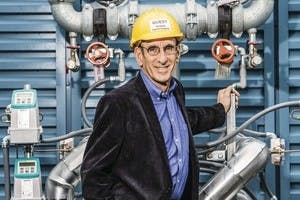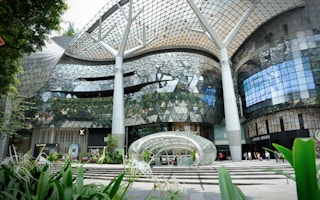Building owners who have saved energy and money by installing glazed windows on their property to keep out the sun’s heat can thank Stephen Selkowitz for developing the coatings that make these savings possible.
Dubbed “the Steve Jobs in the world of energy efficient buildings”, the American researcher on building energy efficiency has spent much of his 36-year long career looking at ways to reduce the energy lost through building envelopes – that is, the windows, walls, and roofs that separate the building interior from the outdoors.
For two decades since the late 1980s, he led a research team at the Lawrence Berkeley National Laboratory which developed “low-e” or low-emissivity window coatings that reduced the amount of heat that passes through glass.
Selkowitz also helped take the product from the laboratory to market by working closely with governments, architects and contractors. Today, this technology is used in buildings across the world and has saved US$7.7 billion in energy costs to date according to the US National Academy of Scientists.
Selkowitz was also the brains behind the “most advanced building efficiency simulator in the world” - the Facility for Low Energy Experiments (FLEXLab) launched in 2013. This unique facility consists of four testbeds where users can trial energy efficienct features such as skylights, window materials and cooling systems on a small scale before implementing them in commercial projects.
For his ground-breaking work, Selkowitz - who leads the Windows and Envelope Materials Group at the Lawrence Berkeley National Laboratory’s building technology and urban systems department - received a Lifetime Achievement Award from the laboratory in 2012. He was also given an award of excellence by McGraw Hill Construction’s industry publication, the Engineering News-Record, earlier this year.

Stephen Selkowitz. Image: Eric Millette
Selkowitz will be speaking on sustainability leadership at the opening plenary of the upcoming International Green Building Conference (IGBC), a three-day event organised by Singapore’s Building and Construction Authority (BCA) which will convene over 1,000 professionals from the sector in the first week of September in the city-state.
In the run-up to IGBC, Selkowitz talks to Eco-Business about the unique challenges that Singapore’s hot and humid climate poses to building energy efficiency, the possibility of a future where zero-energy buildings are the norm, and how energy efficient innovations can make the leap from laboratory to market.
Singapore’s hot and humid environment poses a unique set of challenges in maintaining indoor environments at comfortable levels. What are some technologies and architectural concepts that can help achieve this in the most energy efficient way possible?
There are three major challenges to managing indoor environments in hot, humid climates.
The first is to aggressively control the incident sunlight and diffuse light from the sky so that enough daylight is admitted to offset electric light – but no more, since that would only add to cooling loads. This can be done with proper window design, glass selection and shading controls. The shape and orientation of the overall building, and adjacent landscaping, is also part of this challenge.
The second is to minimize unnecessary internal heat gains since they only make the cooling loads higher.
The third challenge is to address the fact that different parts of a building have different cooling needs, based on different occupancy levels. So cooling systems must not only be energy efficient in terms of cooling hardware, systems design and operational controls, but they should also meet the realistic comfort needs of occupants.
“
The green building sector must grow globally if we are to address the climate change problem. We can make this a classic win-win solution.
Stephen Selkowitz, Senior Advisor, Building Science, Lawrence Berkeley National Laboratory
Your research also focuses on zero energy buildings. Singapore has one Zero Energy Building, by the Building and Construction Authority. Is the concept of zero energy building scaleable and economically viable today? If not, what is needed to move zero energy buildings beyond niche experiments?
Zero Energy Buildings (ZEB) are one part of a broader strategy to transform buildings to dramatically reduce energy use and carbon emissions. The idea of a building that doesn’t need any more energy than it produces on its own site is simple to grasp and appealing, although there are complex technical factors to consider.
The goal may be viewed more as an aspirational goal - a direction in which we are headed, even if every building cannot reach it. For example, high-rise office buildings with high internal computer loads or hospitals are unlikely to meet the zero energy building definition on their site, but they could reduce energy use by more than 60 per cent, and then provide some onsite power and some remote renewable power. It will be harder to scale ZEB in Singapore than in California because of the climate and building density.
In Europe and the US, the concept is shifting from ‘Net Zero’ to ‘Nearly Zero’. This is a more flexible concept, and also includes the idea of ‘Zero Energy Ready’ - meaning an aggressive efficiency programme has lowered the intrinsic energy use to a level that might make ‘Zero’ feasible if renewables were added later.
How can the public and private sectors and academia work together to make a country’s buildings more sustainable?
Our experience shows that the public sector is the right forum in which to discuss and agree upon goals to reduce building energy usage, but the private sector must ultimately shoulder much of the burden to achieve those goals. This may be disruptive for some businesses, but it provides many new opportunities for companies to grow and prosper as well.
Given the role that building energy usage plays in our society and the importance of buildings to health, comfort and productivity, we must take the challenge of reducing this energy usage and convert it to an opportunity. Because it is not affected by existing investments, academia is often the right place to foster the kind of “out of the box” thinking and cutting edge, integrated R&D that is needed to make buildings energy efficient.
But some of most exciting advances come when all three groups collaborate to optimize their respective strengths on what is a very challenging problem.
You recently received a Lifetime Achievement Award for Societal Impact from the Berkeley Lab for your contributions to making buildings in the USA more energy efficient. What has been the most memorable project of your career?
A good part of my work over the years has been tackling the energy challenges related to glazing, windows and daylighting. I like working with technology, and the work has been both innovative but pragmatic, and it has engaged a wide range of partners from manufacturers, to architects to contractors.
These public-private partnerships have advanced concepts like low-emissivity (low-E) window coatings from a lab curiosity in the 1980s to mainstream products that now capture 80 per cent of US sales and have saved billions of dollars in energy. This has been one of the most interesting and important accomplishments for me, which has played out over many years. I enjoy the discovery in the lab but I also like to see impacts on day-to-day practice in real buildings.
What is your vision for how the green building sector should grow globally over the next few decades?
The green building sector must grow globally if we are to address the climate change problem. We can make this a classic win-win solution. Much of the developed world needs to retrofit existing buildings and the developing world needs to build the new infrastructure to employ and house the people who lack these amenities now.
The associated challenges of transport, water and food are complex. They have an impact on, and are affected by the design of buildings and cities as well, but any challenge like this presents an opportunity to push innovation, to create new jobs, and to transform the building sector in a manner that dramatically reduces global energy impacts while enhancing health and comfort.
That would seem like a vision that is worthwhile to pursue at a global scale.















